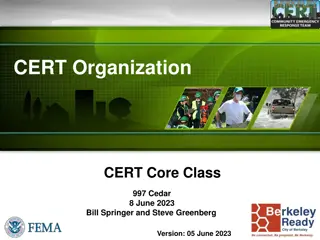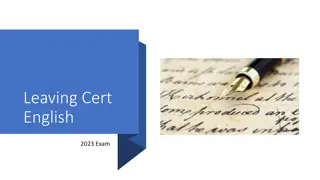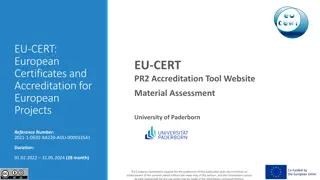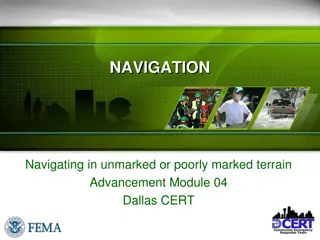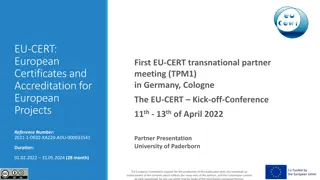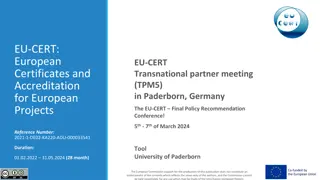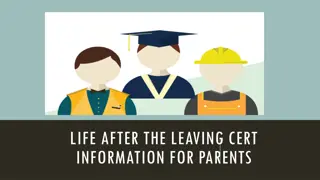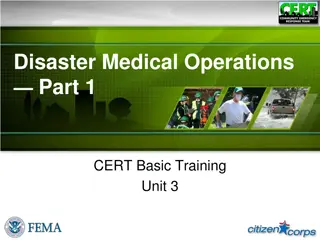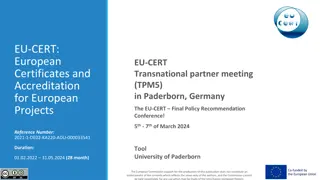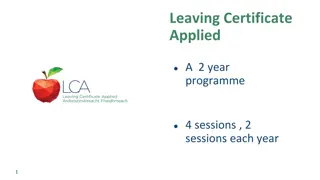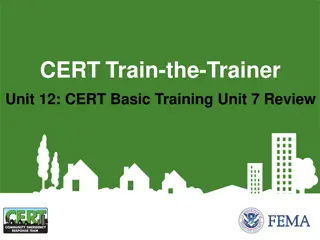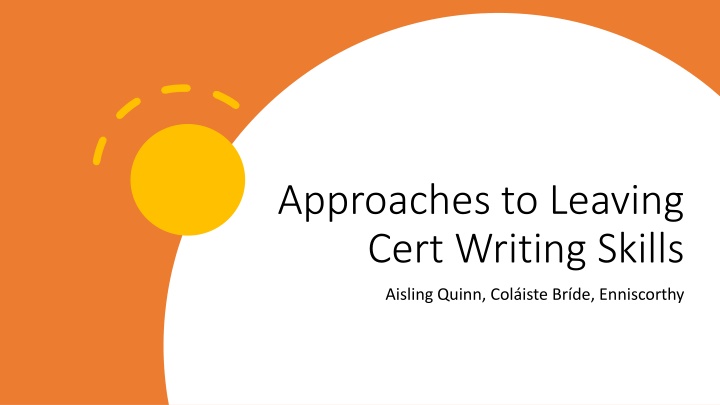
Optimizing Leaving Cert Writing Skills: Strategies for Success in History
Discover effective approaches for maximizing marks in Leaving Cert History writing, with insights from the 2023 exam. Learn how to address common pitfalls, improve source evaluations, and enhance overall essay quality to achieve better outcomes.
Download Presentation

Please find below an Image/Link to download the presentation.
The content on the website is provided AS IS for your information and personal use only. It may not be sold, licensed, or shared on other websites without obtaining consent from the author. If you encounter any issues during the download, it is possible that the publisher has removed the file from their server.
You are allowed to download the files provided on this website for personal or commercial use, subject to the condition that they are used lawfully. All files are the property of their respective owners.
The content on the website is provided AS IS for your information and personal use only. It may not be sold, licensed, or shared on other websites without obtaining consent from the author.
E N D
Presentation Transcript
Approaches to Leaving Cert Writing Skills Aisling Quinn, Col iste Br de, Enniscorthy
Explore how students can adapt their writing skills to maximise their marks in Leaving Cert History, using examples from Leaving Cert 2023. Draw attention to some problem areas that caused students to lose marks and examine approaches to overcome these problems. Learning Intentions
Outline Plan Define & Justify: State what your essay is about and back up with a few lines on why or how it is historically significant. Aims: 3 or 4 aims about what you will include in your essay. Try keep 3 specific to the content. Could include a general aim about research skills etc. Approach: Outline the steps you will take to carry out the RSR, from starting the research to writing the essay. Should be in future tense. Properly cite 3 main sources.
Students have 2 pages to evaluate their 3 main sources. They do not need to fill the 2 pages but should devote equal space to each source. Don t include evaluations of any further sources. Evaluations should include information about relevance, strengths and weaknesses. They should be specific and not generic. Evaluation of Sources
All statements should be backed up with examples. E.g. Photos of __________,_________& __________/ Maps of __________ & ____________/Difficult language such as ___________,____________ & _________. Students find these difficult, but it is worth taking the time to get them right. Links in with DBQ section/ links with English. Ask students to brainstorm information, divide information into relevance, strengths and weaknesses and then to develop their points using examples. Cont ..
Keep these questions in mind when planning and writing the essay; 1. Is it thorough, accurate and relevant to the title? 2. Is there appropriate depth of investigation? 3. Have I referred to my sources? 4. Is there a fair and balanced treatment of issues? 5. Is it literate, coherent and well- structured? Extended Essay
Choose a narrow focus. Choose authentic and reliable sources. Keep it as detailed as possible. Cont .. Include a selection of quotes and/or refer to your sources throughout. Quotes should be referenced. References can be in any form footnotes, endnotes, or simply (Source 1) etc. Write an impactful conclusion that ties it all together and brings it all back to the title. Remember to keep within the date parameters - Ireland 1993 and Europe 1992.
Review Write a short paragraph on each of the following to get the full 10m for the review. How/ why did you decide on this topic? How did you carry out the process and how did you find it? Did you achieve the aims you set out in your outline plan? elaborate What did you find particularly interesting about your topic/ the process? spend time on this and make it as personal as possible
Cont.. What skills did you learn/ develop through the process? What difficulties did you encounter and how did you overcome them? spend time on this and make it as personal as possible. What might you do differently if you were to start again?
Options for the 2024 written paper Normal: DBQ EU 3 2 Irish topics (1 question each) 1 European topic (1 question) Adjusted: DBQ EU 3 & 1 of the following options; 3 questions from 2 Irish topics 2 questions from 1 Irish topic and 1 question from 1 European topic 1 question from 1 Irish topic and 2 questions from 1 European topic
Get the timing right 2 hours 50 minutes 42.5 minutes per question. Or DBQ 50 minutes and 40 minutes per essay. Move on with the clock even if essay isn t finished.
Very short answers, direct from the sources. Look out for the odd question that might have 2 parts e.g. In document A, how were the UDA men dressed and armed? Some were holding sticks and one appeared to have a mask on. Comprehension Questions
Do both documents give similar descriptions of the activities of the strike supporters? Explain your answer, referring to both documents. Best approach answer question, extract 2/3 pieces of evidence and quote(s) from doc A to back it up and then do the same with doc B. Read the full question carefully. Do both documents give similar descriptions of the response of the security forces to the presence of journalists? Explain your answer, referring to both documents. Quite a few students missed the part about the journalists and got 0. Comparison Questions
What would you consider to be the value of document A as a historical source? Explain your answer, making reference to the document. Best approach answer question, general information on the type of source, back up with specific evidence and quotes from the document. Criticism Questions
Would you consider document B to be an objective source? Give reasons for your answer, making reference to the document. Best approach answer question, define objective, back up with specific evidence and quotes from the document. Needed to show that they understood the concept of objectivity as it applies in this context. Cont ..
Sample Answer 10m Olivia O Leary identifies herself as an Irish person and is writing for a Dublin newspaper. It is impossible for her to be completely objective. She feels emotional about the events she witnesses, describing how her mouth was as dry as sawdust . Her choice of vocabulary can show her anti-striker bias. She calls them a loyalist mob . She is biased in favour of the power sharing executive, and seems quite fearful that the strike is wrecking the only real attempt at shared government in Northern Ireland . Although she has strong opinions about the events she is witnessing, her description of these events is fair, and this is confirmed by the similarities between her account and Fisk s account of how the strikers and soldiers behaved.
Try to write a 1.5/2 pages. Be very careful with the introduction. All background material gets a max of 12m. Set the scene in the intro only and start answering the question directly by paragraph 2. Why did the Sunningdale Agreement and the power-sharing executive, 1973-1974, prove so divisive? Far too much background given in many cases and then candidates ran out of time before the very relevant information. Keep paragraphs short and linked to the title. Contextualisation
Practice DBQs take a lot of practice. Begin without time constraints and then introduce the clock. Encourage students to pack their answers with evidence. Use DBQ samples from other topics for practice. Ask students to count how many pieces of evidence they use in their answers.
The Cumulative Mark Paragraphs are awarded 0-12 marks using the following scale: Cumulative Mark (CM) (Maximum = 60 marks) Excellent: 11-12 marks Outstanding piece of analysis, exposition or commentary. Clearly expressed, accurate and substantial information. Very good: 8-10 marks Very good information, accurately and clearly expressed. Good: 6-7 marks Worthwhile information, reasonably well expressed. Fair: 3-5 marks Limited information/barely stated. Poor: 0-2 marks Trivial/irrelevant/grave errors.
Overall Evaluation (40 marks max.) Excellent: 34-40 Very good: 28-33 Good: 22-27 Fair: 16-21 Weak: 10-15 Very weak: 0-9 Excellent in its treatment of the set question, particularly if it shows detailed learning, wide reading, or extensive coverage. Very good but not excellent in its treatment of the set question, i.e.: accurate and substantial. Good standard treatment of the set question, without being exceptional in the information or the commentary supplied. Fair attempt at the set question, but has identifiable defects, eg: incomplete coverage, irrelevant data, factual inaccuracies. Poor, in that it fails to answer the question as set, but has some merit. Very poor answer which, at best, offers only scraps of information.
Most effective general approaches to essay writing
Perfect Practice Makes Perfect
Choose the right essay. Make sure you understand the question and know enough content to fill 5 pages. Try to write approx. 5 pages. Please keep the writing legible. We can t mark what we can t read. Condense all background information into the introductory paragraph. This takes practice. At what point is my information directly answering the question? What do I need to say to set the scene?
Try to get a balance between a paragraph thats too skimpy and saying nothing and paragraphs that are far too long. Long paragraphs should be split or shortened. Link every paragraph directly to the question. The negotiation of the Anglo-Irish Treaty, 1938, demonstrates how skilfully de Valera handled Anglo-Irish relations. The Nuremberg Rallies highlight how propaganda was a main characteristic of fascist regimes in Europe. The passing of the Voting Rights Act was a successful attempt to tackle racial inequality in the US.
Trial a few approaches to help embed this important practice. Ask essay style questions orally as you move through the different parts of a topic e.g. Why did the successful use of peaceful protest make the boycott significant?/ How was the invention of the Hydrogen bomb a key development in military technology? Ask students to underline their link sentences in their essays. Ask students to swap essays and locate and underline link sentences in their peer s essay. Keep the information relevant.
During the period 1923-1945, how skillfully did W.T. Cosgrave and amon de Valera handle Anglo-Irish Relations? Quite a few included info on consolidating democracy and social and economic.
Different question formats and how to approach them Case Studies: Be careful of case studies when they come up on their own e.g. Eucharistic Congress, Jarrow March, Apprentice Boys of Derry. Do you know enough content? More than 1 element: During the period 1923-1945, how skilfully did W.T. Cosgrave and amon de Valera handle Anglo-Irish relations? What were the challenges facing France in peace and war, 1920-1945? Max of 50cm and penalty on oe if only 1 part is addressed.
Cont. Plurals: What were the main characteristics of fascist regimes in Europe, 1920-1945? Must write about at least 2 characteristics in at least 2 fascist regimes or max 50 cm and penalty on oe. One or more: How did one or more of the following contribute to tensions in Ireland: the Home Rule Bill, 1912-1914; World War I; the 1918 election? During the period 1945-1992, how was Europe impacted by one or more of the following: advances in the biological sciences; nuclear power; the computer? Can address 1, 2 or 3 parts.
Cont.. And/Or: What was the impact on Irish life of the 1932 Eucharistic Congress and/or of attempts to promote the Irish language? How well did Se n Lemass and/or Jack Lynch tackle the problems he faced? How did Josef Stalin transform the Soviet economy and/or use show trials to consolidate his power? Social & Economic: During the period 1960-1990, what were the social and economic effects of European withdrawal from empire on foreign colonies in Africa? Social & economic taken together no limit on cm. Would need more than 1 colony though!!
Cont.. Date Parameters: Most date parameters give the topic range. What attempts were made to tackle racial inequality in the US, 1945-1989? Look out for titles that don t span the full range. During the period 1923-1945, why did Irish governments find it difficult to achieve economic success? (2022) What were the key social and economic developments in Northern Ireland, 1949- 1969? (2021) Would you agree that Stalin transformed the Soviet Union, 1924-1945? (2021) Info prior to date parameters will all be marked as background material and any info after date parameters will all be marked as concluding material max 12m

